<Home>
<Info.
form Artists>
Show
Review
Hakon
Storm Mathisen with Takehito Kobayashi Group
"Norwegian Jazz Nights"
Nov 17, 2003 at Welcome Back, Otsuka, Tokyo
Norway's
top guitarist/composer/arranger and Japan's jazz experts in collaboration to bring
the worlds together in rhythm.
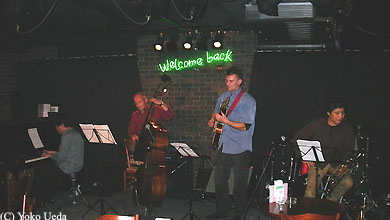
Interview
With Hakon Storm
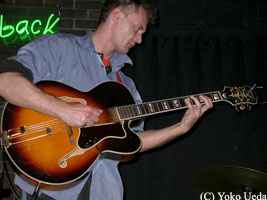 Hakon
Storm-Mathisen is one of Norway's top contemporary guitar players. He has given
performances all over Europe, in USA, and in Africa with his own groups and as
a side man. He is also a reputed composer of big band music, and has performed
his music with some of the best bands and soloists in Norway. Hakon Storm is a
teacher at the Norwegian State Academy of Music in Oslo, and has given lectures
and master classes at conservatories in Holland, Belgium, and Serbia.
Hakon
Storm-Mathisen is one of Norway's top contemporary guitar players. He has given
performances all over Europe, in USA, and in Africa with his own groups and as
a side man. He is also a reputed composer of big band music, and has performed
his music with some of the best bands and soloists in Norway. Hakon Storm is a
teacher at the Norwegian State Academy of Music in Oslo, and has given lectures
and master classes at conservatories in Holland, Belgium, and Serbia.
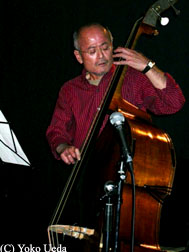 During
this tour in Japan he performed at 8 venues in Tokyo, Osaka and Toyama with different
Japanese musicians for each of the performances, and this is the last of the series.
Tonight's performance was with Takehito Kobayashi Group. Takehito Kobayashi is
a bass player with long standing career behind him in Japan, USA and Europe. He
performs regularly at Welcome Back Ohtsuka where he is the leader of the band
for monthly "Jazz Jam Session". Also, 2 Album releases are planned for
2004 featuring his own compositions.
During
this tour in Japan he performed at 8 venues in Tokyo, Osaka and Toyama with different
Japanese musicians for each of the performances, and this is the last of the series.
Tonight's performance was with Takehito Kobayashi Group. Takehito Kobayashi is
a bass player with long standing career behind him in Japan, USA and Europe. He
performs regularly at Welcome Back Ohtsuka where he is the leader of the band
for monthly "Jazz Jam Session". Also, 2 Album releases are planned for
2004 featuring his own compositions.
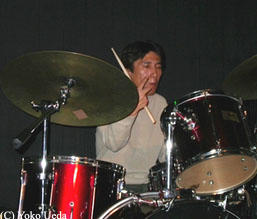
Slow 4 beat opened
the set. It's "Lighthouse Blues" written by Hakon Storm. As the solid
rhythm of Takehito Kobayashi's bass led on, Hakon Storm played bluesy melodies
on his Epiphone Emperor Regent. Ryuichi Takase took Trumpet solo augmented by
the bass that created relaxed groove while Kazuhide Motooka on the piano and Naokatsu
Suzuki on the drums nailed the foundation of the rhythmic structure of the tune.
Kazuhide Motooka's piano solo started rather simplistically but gradually widened
the scope of the sound into a pleasantly rich musical monologue. The bass solo
which followed was remarkable with rich melodic contents spanning across the fretboard.
The title of the song comes from a jazz restaurant in Oslo called "Fyret"
which means lighthouse. The tune is usually played as a duet with another guitarist,
Jacob Young, who is also touring in Japan for the "Norwegian Jazz Nights".
The next tune is a Joe Henderson number , "Recordame". This bright
tune was led off by the trumpet to which Hakon Storm added nice accompaniment
with rich harmonies. The sparkling trumpet solo was followed by Hakon Storm's
guitar solo which came in running up the frets from low strings in a flash, and
showcasing various techniques including fast sweep style arpegiated chords. The
light fingered piano solo that followed became heated as Kazuhide Motooka let
out his passion. The ending sequence was played by the guitar and the trumpet
in unison to give a cool finishing touch.
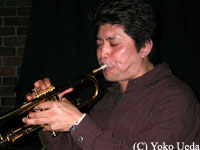 The
third tune was "Little B's Poem" by Bobby Hatcherson. Ryuichi Takase
switched to Flugelhorn and softly played the ballad. The piano accompaniment was
at times reminding of Paul Bley for the abstract atmosphere. Hakon Storm 's solo
was well controlled as if to hold passion within. Toward the end as the piano
solo took on the heat Takehito Kobayashi joined with creative melodies and took
over the solo, which was one of the spectacular moments of the evening.
The
third tune was "Little B's Poem" by Bobby Hatcherson. Ryuichi Takase
switched to Flugelhorn and softly played the ballad. The piano accompaniment was
at times reminding of Paul Bley for the abstract atmosphere. Hakon Storm 's solo
was well controlled as if to hold passion within. Toward the end as the piano
solo took on the heat Takehito Kobayashi joined with creative melodies and took
over the solo, which was one of the spectacular moments of the evening.
"Storm Bird", a swinging up-beat composition by Hakon Storm was played
next. Fast passages on the guitar continued in the style of Wes Montgomery which
was a proof of his prowess on the instrument. Piano solo showed a well thought-out
coordination of melody and rhythm. Naokatsu Suzuki's drumming was noteworthy with
his right hand technique on the ride cymbal that pushed the whole performance
to a great height. An extended exchange between the drums and the guitar was an
excellent example of the fun of jazz performance.
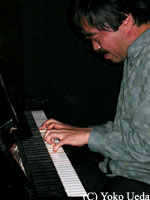 The
last song of the stage was "Song for Japanese American Princess" by
Takehito Kobayashi. Japanese melody was played on the piano on 2/4 then the bass
came in on 3/8 with bluesy riff which presented a unique contrast between Japan
and America. The song opened quietly but promising exciting development. Intricate
rhythmic structure and swinging groove are all in one on this song. Hakon Storm's
guitar added repeating short phrase which was well blended in the ensemble and
brings the performance to a height of excitement. Naokatsu Suzuki pushed forward
with his drums on this tune. Ryuichi Takase's trumpet had a funky taste in the
solo.
The
last song of the stage was "Song for Japanese American Princess" by
Takehito Kobayashi. Japanese melody was played on the piano on 2/4 then the bass
came in on 3/8 with bluesy riff which presented a unique contrast between Japan
and America. The song opened quietly but promising exciting development. Intricate
rhythmic structure and swinging groove are all in one on this song. Hakon Storm's
guitar added repeating short phrase which was well blended in the ensemble and
brings the performance to a height of excitement. Naokatsu Suzuki pushed forward
with his drums on this tune. Ryuichi Takase's trumpet had a funky taste in the
solo.
Kazuhide Motooka came out percussively on the piano, to which
Hakon Storm added a slightly avant-garde atmosphere with the volume technique
to produce sound like the bowed bass. The performance developed into a freeform
jam and then came back around the steady bass with the main riff, which was nothing
short of spectacular. The trumpet and the guitar played the theme in unison and
the song refrained the Japanese melody toward the ending. A very well crafted
song it was to say the least.
This
tour was coordinated by Yosuke Kurosaka of World Project Japan. He also operates
a website called "KIKI JAZZ" (http://www.jjazz.net/kiki/)
which presents jazz standards played by various artists in order to compare and
enjoy.
Musicians:
Hakon Storm: Guitar
Takehito Kobayashi :Bass
Kazuhide
Motooka: Piano
Ryuichi Takase: Trumpet, Flugelhorn
Naokatsu Suzuki: Drums
Set List
1. Lighthouse Blues
2. Recordame
3. Little B's Poem
4. Storm Bird
5. Song for Japanese American Princess
Report by Tatsuro Ueda
Interview by Tatsuro Ueda
Photography
by Yoko Ueda
Design by Asako Matsuzaka
Special Thanks
to COSMO PR, Welcome Back, Otsuka(http://www.welcomeback.jp/)
Interview
With Hakon Storm
Q:There are several things that I want to ask you today. First of all, the
customary question. How do you like Japan?
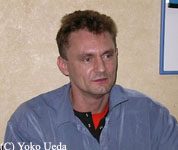 Hakon:
I love Japan! This is the first time I am in Japan, and I like everything about
Japan. I was a little sceptical when I arrived here about having rice and fish
for breakfast, but I really enjoy the food. Of course I'd only known little about
Japan before the tour. I've been playing every day, travelling, and getting the
right picture of Japan.
Hakon:
I love Japan! This is the first time I am in Japan, and I like everything about
Japan. I was a little sceptical when I arrived here about having rice and fish
for breakfast, but I really enjoy the food. Of course I'd only known little about
Japan before the tour. I've been playing every day, travelling, and getting the
right picture of Japan.
Q: Did
you get a chance to take a look around and try fish and rice for breakfast?
Hakon:
Yes, I took one day off and visited Kyoto. I saw temples and shrines, as well
as palaces. Also, it was yesterday, I went to see the Taiko drummer, the Kodo.
That was one of the things I wanted to do in Japan, even I was going to Sado island
to see them but by coincidence they were playing in Tokyo so it was a lucky situation.
Q: You've played
with many Japanese musicians. Is there differences from playing with the local
musicians in Norway?
Hakon:
It's different in many ways. Also from night to night I played with different
musicians. Tonight is the last of eight performances in Japan on this tour, every
night with a different band.
The ones I played with tonight are very different
from those from yesterday. When I play in Norway I play with my old band, and
I have a very strong opinion about what it's going to be like when I start playing
there, but here I don't have that so much so maybe I am more open minded here.
You can't do the same thing every night here, you have to listen to the other
musicians and find something that works. So that's very interesting.
Q: What about today's band, how did you like
playing with them?
Hakon:
I enjoyed very much. I think the second set was better, as we had better feeling
of each other than the first set and got loosened up more. I wish we had more
time to play together. The drummer has a special right hand technique. I like
Kobayashi's bass with gut strings, on the upper two strings. The piano player
is really good. Also I am very much fond of the trumpet player. He's really good.
Q: You've played with many Norwegian
musicians including Jacob Young.
Hakon:
Yes, Jacob and I have a duo and do regular gigs at a small cafe, and it's good
to play with him.
Q: Do you ever
get to play at Bodil Niska's Bare Jazz?
Hakon: Yeah,
I've played there twice. But that's sometime ago. The place is a small one with
three floors including the basement. They have occasional concerts about once
a month.They usually have concerts for new CD release, and it gets totally packed
with 30-40 people.
Q: I hear
that you've played with Beate Lech of Beady Belle.
Hakon:
Yes, she played in my band. I have a quintet and songs for vocals, so she sings.
She's one of the greatest singers, extremely skilled in singing, like not many
can. If you give her something in odd meters, as in 7, 9 or 5, and keys that modulate
around different tonalities, and she can sing right off the music, while other
musicians have trouble figuring it out. She's an extremely good and very educated
musician, with a beautiful voice, and great phrasing, too.
Q:
How does a guitarist like yourself write music for big band? How do you compose?
Hakon:
In very many different ways. Those I played tonight are more in standard style.
I also write more contemporary style big band music, which is more tonal and still
contemporary, like post-Count Basie. Then I write even more contemporary music
from technical point of view which provides me experimental ground. I'm always
trying to learn new ways to do things. Of course writing big band music is something
I like. I did extensive study in big band music in conservatoy, and later by myself
on books and scores, listening to different composers I admire. It's not something
that comes easy.
Q: When you
compose, do you compose on the guitar, or piano, or right on the sheet music?
Hakon:
That depends on what kind of music I write, but for big band music I do pen and
paper, mostly. I would have concepts collected over years from many sources of
influence. Things don't come up out of nowhere. It's mostly done as a handicraft
with a little bit of inspiration.
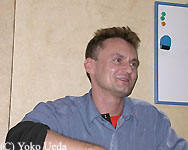 Q:
Who are your favorite composers and musicians?
Q:
Who are your favorite composers and musicians?
Hakon:
Recently I've been listening to newer western composers like Olivier Messiaen,
Bela Bartok, Igor Stravinsky, and other contemporary composers. In Jazz, I admire
Maria Schneider. I think she is very good. I also like Gil Evans.
Q:
What about guitarists?
Hakon:
Of jazz guitarists I've always been a big fan of John McLaughlin. He's one of
my favorite players. His creative energy, control and balance are perfect. Of
course I like Wes Montgomery.
Q:
Back to question about Norway, who do you play with besides Jacob Young?
Hakon:
I have my own trio with Finn Guttormsen on bass and Jarle Vespestad on drums.
They have been to Japan with a band called Farmer's Market.
Q:
You played a song called "Storm Bird". Where does the title come from?
Hakon:
Well, Charlie Parker wrote "Yardbird Suite", and Lennie Tristano, a
great pianist and composer whom I admire a lot, wrote "Lenny Bird",
so I wrote "Storm Bird" following their steps.
Q:
I imagine that in order to play so wonderfully you must practice alot, is that
right?
Hakon: I had a period
when I practiced many hours everyday. Now I practice more intensively in periods,
up to important performances or recording sessions, or when I study a particular
new subject to me. Sometimes I only compose for a long time and don't play at
all. When I teach I play the guitar but that doesn't let me learn new techniques
as I focus more on understanding students than myself.
Q:
About your guitar, is that an Epiphone?
Hakon:
Yes, this is an Epiphone and it's my travelling guitar. I have a Gibson ES175
from 1953 back home but I don't travel with it. I'm too scared of the way the
airline company handles the luggage, and it costs a lot to buy my guitar a seat.
This Epiphone is a modern version from 1994, and it's a great sounding guitar.
I think it's worth 10 times more than the price. But the core of the tone of old
Gibson is something special and that only comes from Gibson.
Q:
Thank you very much for taking time. Have a nice flight back home!
Hakon: Thank you!
Copyright (C) 2003 Global
Artist Network. All rights reserved.

 Hakon
Storm-Mathisen is one of Norway's top contemporary guitar players. He has given
performances all over Europe, in USA, and in Africa with his own groups and as
a side man. He is also a reputed composer of big band music, and has performed
his music with some of the best bands and soloists in Norway. Hakon Storm is a
teacher at the Norwegian State Academy of Music in Oslo, and has given lectures
and master classes at conservatories in Holland, Belgium, and Serbia.
Hakon
Storm-Mathisen is one of Norway's top contemporary guitar players. He has given
performances all over Europe, in USA, and in Africa with his own groups and as
a side man. He is also a reputed composer of big band music, and has performed
his music with some of the best bands and soloists in Norway. Hakon Storm is a
teacher at the Norwegian State Academy of Music in Oslo, and has given lectures
and master classes at conservatories in Holland, Belgium, and Serbia. During
this tour in Japan he performed at 8 venues in Tokyo, Osaka and Toyama with different
Japanese musicians for each of the performances, and this is the last of the series.
Tonight's performance was with Takehito Kobayashi Group. Takehito Kobayashi is
a bass player with long standing career behind him in Japan, USA and Europe. He
performs regularly at Welcome Back Ohtsuka where he is the leader of the band
for monthly "Jazz Jam Session". Also, 2 Album releases are planned for
2004 featuring his own compositions.
During
this tour in Japan he performed at 8 venues in Tokyo, Osaka and Toyama with different
Japanese musicians for each of the performances, and this is the last of the series.
Tonight's performance was with Takehito Kobayashi Group. Takehito Kobayashi is
a bass player with long standing career behind him in Japan, USA and Europe. He
performs regularly at Welcome Back Ohtsuka where he is the leader of the band
for monthly "Jazz Jam Session". Also, 2 Album releases are planned for
2004 featuring his own compositions.
 The
third tune was "Little B's Poem" by Bobby Hatcherson. Ryuichi Takase
switched to Flugelhorn and softly played the ballad. The piano accompaniment was
at times reminding of Paul Bley for the abstract atmosphere. Hakon Storm 's solo
was well controlled as if to hold passion within. Toward the end as the piano
solo took on the heat Takehito Kobayashi joined with creative melodies and took
over the solo, which was one of the spectacular moments of the evening.
The
third tune was "Little B's Poem" by Bobby Hatcherson. Ryuichi Takase
switched to Flugelhorn and softly played the ballad. The piano accompaniment was
at times reminding of Paul Bley for the abstract atmosphere. Hakon Storm 's solo
was well controlled as if to hold passion within. Toward the end as the piano
solo took on the heat Takehito Kobayashi joined with creative melodies and took
over the solo, which was one of the spectacular moments of the evening. The
last song of the stage was "Song for Japanese American Princess" by
Takehito Kobayashi. Japanese melody was played on the piano on 2/4 then the bass
came in on 3/8 with bluesy riff which presented a unique contrast between Japan
and America. The song opened quietly but promising exciting development. Intricate
rhythmic structure and swinging groove are all in one on this song. Hakon Storm's
guitar added repeating short phrase which was well blended in the ensemble and
brings the performance to a height of excitement. Naokatsu Suzuki pushed forward
with his drums on this tune. Ryuichi Takase's trumpet had a funky taste in the
solo.
The
last song of the stage was "Song for Japanese American Princess" by
Takehito Kobayashi. Japanese melody was played on the piano on 2/4 then the bass
came in on 3/8 with bluesy riff which presented a unique contrast between Japan
and America. The song opened quietly but promising exciting development. Intricate
rhythmic structure and swinging groove are all in one on this song. Hakon Storm's
guitar added repeating short phrase which was well blended in the ensemble and
brings the performance to a height of excitement. Naokatsu Suzuki pushed forward
with his drums on this tune. Ryuichi Takase's trumpet had a funky taste in the
solo.  Hakon:
I love Japan! This is the first time I am in Japan, and I like everything about
Japan. I was a little sceptical when I arrived here about having rice and fish
for breakfast, but I really enjoy the food. Of course I'd only known little about
Japan before the tour. I've been playing every day, travelling, and getting the
right picture of Japan.
Hakon:
I love Japan! This is the first time I am in Japan, and I like everything about
Japan. I was a little sceptical when I arrived here about having rice and fish
for breakfast, but I really enjoy the food. Of course I'd only known little about
Japan before the tour. I've been playing every day, travelling, and getting the
right picture of Japan. Q:
Who are your favorite composers and musicians?
Q:
Who are your favorite composers and musicians?